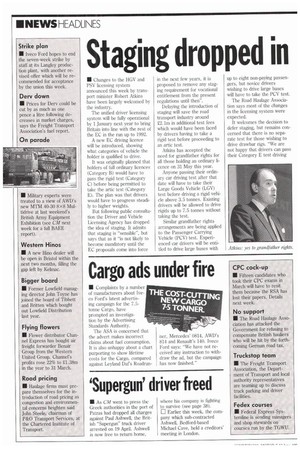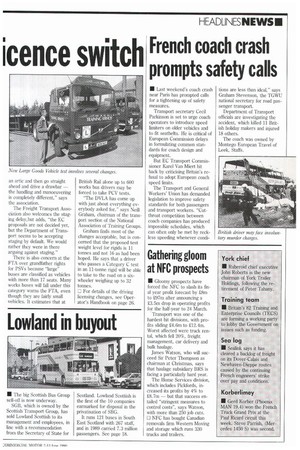Staging dropped in icence switch
Page 6

Page 7

If you've noticed an error in this article please click here to report it so we can fix it.
• Changes to the HGV and PSV licensing system announced this week by transport minister Robert Atkins have been largely welcomed by the industry.
The unified driver licensing system will be fully operational by 1 January next year to bring Britain into line with the rest of the EC in the run up to 1992.
A new EC driving licence will be introduced, showing what categories of vehicle the holder is qualified to drive.
It was originally planned that holders of full ordinary licences (Category B) would have to pass the rigid test (Category C) before being permitted to take the artic test (Category E). The plan was that drivers would have to progress steadily to higher weights.
But following public consultation the Driver and Vehicle Licensing Agency has dropped the idea of staging. It admits that staging is "sensible", but says that as it "is not likely to become mandatory until the EC proposals come into force in the next few years, it is proposed to remove any staging requirement for vocational entitlement from the present regulations until then".
Delaying the introduction of staging will save the road transport industry around .22.1m in additional test fees which would have been faced by drivers having to take a rigid test before proceeding to an artic test.
Atkins has accepted the need for grandfather rights for all those holding an ordinary licence on 31 May this year.
Anyone passing their ordinary car driving test after that date will have to take their Large Goods Vehicle (LGV) test before driving a rigid vehicle above 3.5 tonnes. Existing drivers will be allowed to drive rigids up to 7.5 tonnes without taking the test.
Similar grandfather rights arrangements are being applied to the Passenger Carrying Vehicle (PCV) test. Experienced car drivers will be entitled to drive large buses with up to eight non-paying passengers, but novice drivers wishing to drive large buses will have to take the PCV test.
The Road Haulage Association says most of the changes in the licensing system were expected.
It welcomes the decision to defer staging, but remains concerned that there is no separate test for those wishing to drive drawbar rigs. "We are not happy that drivers can pass their Category E test driving an artic and then go straight ahead and drive a drawbar — the handling and manoeuvering is completely different," says the association.
The Freight Transport Association also welcomes the staging delay,but adds, "the EC proposals are not decided yet, but the Department of Transport seems to be accepting staging by default. We would rather they were in there arguing against staging."
There is also concern at the FTA over grandfather rights for PSVs because "large" buses are classified as vehicles with more than 17 seats. Many works buses will fall under this category warns the FTA, even though they are fairly small vehicles. It estimates that at British Rail alone up to 600 works bus drivers may be forced to take PCV tests.
"The DVLA has come up with just about everything everybody asked for," says Neil Graham, chairman of the transport section of the National Association of Training Groups.
Graham finds most of the changes acceptable, but is concerned that the proposed test weight level for rigids is 11 tonnes and not 16 as had been hoped. He says that a driver who passes a Category C test in an 11-tonne rigid will be able to take to the road on a sixwheeler weighing up to 32 tonnes.
0 For details of the driving licensing changes, see Operator's Handbook on page 26.




































































































































